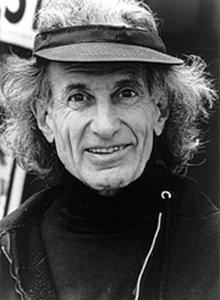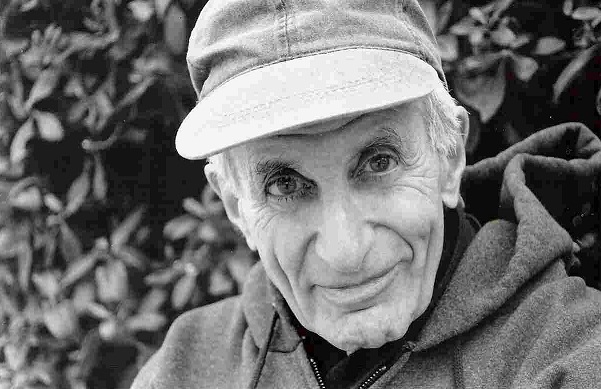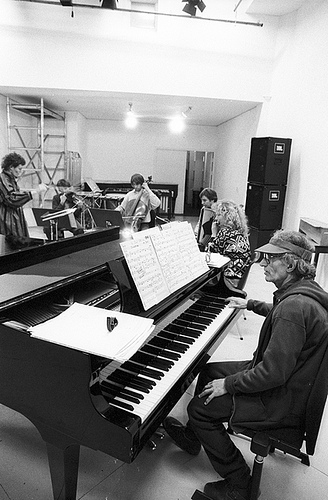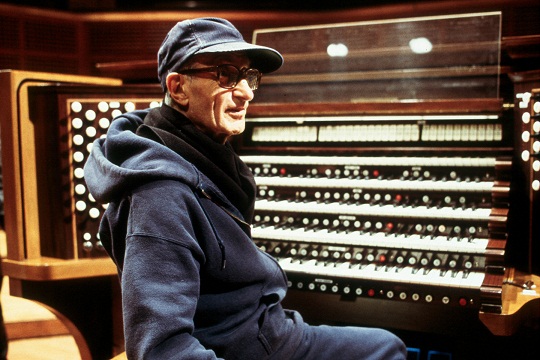<Back to Index>
- Composer Henry Dreyfuss Brant, 1913
PAGE SPONSOR


Henry Dreyfuss Brant (September 15, 1913 – April 26, 2008) was a Canadian born American composer. An expert orchestrator with a flair for experimentation, many of Brant's works featured spatialization techniques.
Brant was born in Montreal, Quebec, Canada, of American parents in 1913, Henry Brant began composing at the age of eight, and studied first at the McGill Conservatorium (1926 – 29) and then in New York City (1929 – 34). The son of a professional violinist, Brant played violin, flute, tin whistle, piano, organ and percussion at a professional level and was fluent with the playing techniques for all of the standard orchestral instruments. As a teenager, he was the youngest composer included in Henry Cowell's landmark book American Composers on American Music, demonstrating an early identification with the American experimental musical tradition. Brant was represented in Cowell's anthology by an essay on oblique harmony, an idea which presaged some techniques used in his mature spatial works. He composed, orchestrated and conducted for radio, film, ballet and jazz groups. The stylistic diversity of these professional experiences would also eventually contribute to stylistic polyphony of his mature works. Starting in the late 40s, he taught at Columbia University, the Juilliard School and, for 24 years, Bennington College. In the mid 1950’s Brant felt that “single style music … could no longer evoke the new stresses, layered insanities, and multi - directional assaults of contemporary life on the spirit.” In pursuit of an optimal framework for the presentation of a music which embraced such a simultaneity of musical textures and styles, Brant made a series of experiments and compositions exploring the potential for the physical position of sounds in space to be used as an essential compositional element.
In addition to his works for the concert hall, he was active as an orchestrator for many Hollywood productions including the Elizabeth Taylor movie Cleopatra (1963), one of many collaborations with composer Alex North. Brant helped with the orchestration of North's score for 2001, and due to North's stress - induced muscle spasms, Brant had to conduct the recording session for the film score. He also worked as orchestrator for composers Virgil Thomson, Aaron Copland, George Antheil, Douglas Moore and Gordon Parks. Brant's work as an orchestrator was not limited to film and stage: his long term affinity for the music of Charles Ives — whose The Unanswered Question was an acknowledged inspiration for Brant's spatial music — was ultimately found in the premier of Brant's arrangement of Ives' Second Piano Sonata, "Concord, Mass 1840 - 60" as A Concord Symphony in 1996.
From 1981, he made his home in Santa Barbara, California, where he died on April 26, 2008 at the age of 94.
Beginning with the 1953 score Rural Antiphonies (predating Stockhausen's Gruppen of 1955 - 57), Brant developed the concept of spatial music, in which the location of instruments and/or voices in physical space is a significant compositional element. He identified the origins of the concept in the antiphonal music of the late renaissance and early baroque, in the antiphonal use of four brass ensembles placed in the corners of the stage in the Requiem of Hector Berlioz and, most importantly, in works of Charles Ives, in particular The Unanswered Question. Henry Brant was America’s foremost composer of acoustic spatial music. The planned positioning of performers throughout the hall, as well as on stage, was an essential factor in his composing scheme and a point of departure for a radically expanded range and intensity of musical expression. Brant’s mastery of spatial composing technique enabled him to write textures of unprecedented polyphonic and/or polystylistic complexity while providing maximum resonance in the hall and increased clarity of musical detail for the listener. His catalog comprises over 100 spatial works.
In keeping with Brant’s belief that music can be as complex and contradictory as everyday life, his larger works often employ multiple, contrasting performing forces, as in Meteor Farm (1982) for symphony orchestra, large jazz band, two choruses, West African drum ensemble and chorus, South Indian soloists, large Javanese Gamelan ensemble, percussion orchestra and two Western solo sopranos. Brant’s spatial experiments convinced him that space exerts specific influences on harmony, polyphony, texture and timbre. He regarded space as music’s “fourth dimension,” (after pitch, time and timbre). Brant experimented with new combinations of acoustic timbres, even creating entire works for instrumental family groups of a single timbre: Orbits for 80 trombones, organ and sopranino voice, Ghosts & Gargoyles for 9 flutes, and others for multiple trumpets and guitars. This predilection for ensembles of a single tone quality dates from Angels and Devils (1932) for an ensemble of 11 flutes. With the exception of pieces composed for recorded media (in which he used over - dubbing or acoustical sound sources), Brant did not use electronic materials or permit amplification in his music.
He is perhaps best known for his compositions Verticals Ascending (conceptually based on the architecture of the Watts Towers in Los Angeles) and Horizontals Extending. A "spatial opera", The Grand Universal Circus (Libretto: Patricia Gorman Brant) was premiered in 1956. Brant won the Pulitzer Prize for Music in 2002 for his composition Ice Field. In addition to composing, he played the violin, flute, tin whistle, percussion, piano and organ and frequently included soloistic parts in his large works for himself to play.
Later premieres included Wind, Water, Clouds & Fire, for 4 choirs and instrumentalists, commissioned by Present Music and premiered on November 19, 2004 at The Cathedral of St. John the Evangelist, Milwaukee, Wisconsin. Tremors, for 4 singers and 16 instrumentalists, commissioned by the Getty Research Institute, premiered on June 4, 2004, at the Getty Center in Los Angeles. Tremors was repeated in a Green Umbrella concert at L.A.’s Walt Disney Concert Hall on November 1, 2004. Ghosts & Gargoyles, a concerto for flute solo with flute orchestra, for New Music Concerts, Toronto, had its premiere on May 26, 2002. Ice Field, for large orchestral groups and organ, was commissioned by Other Minds for a December 2001 premiere by the San Francisco Symphony.
Brant's handbook for orchestration, Textures and Timbres, was published posthumously.
A member of the American Academy of Arts and Letters, Brant was awarded the 2002 Pulitzer Prize in Music for Ice Field (2001), commissioned by Other Minds and premiered by the San Francisco Symphony under the direction of Michael Tilson Thomas. He has received two Guggenheim Fellowships and was the first American composer to win the Prix Italia. Among other honors are Ford Foundation, Fromm Foundation, National Endowment for the Arts and Koussevitzky awards and the American Music Center’s Letter of Distinction. The Paul Sacher Foundation in Basel has acquired Brant’s complete archive of original manuscripts including over 300 works (1998). In conjunction with Brant’s 85th birthday concert, Wesleyan University conferred upon him the honorary degree of Doctor of Fine Arts (1998).

